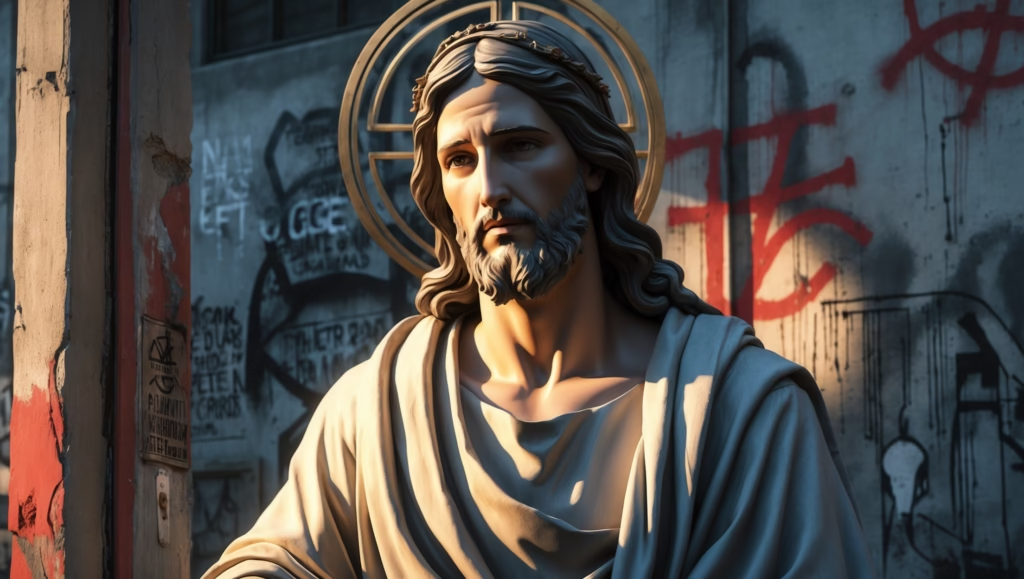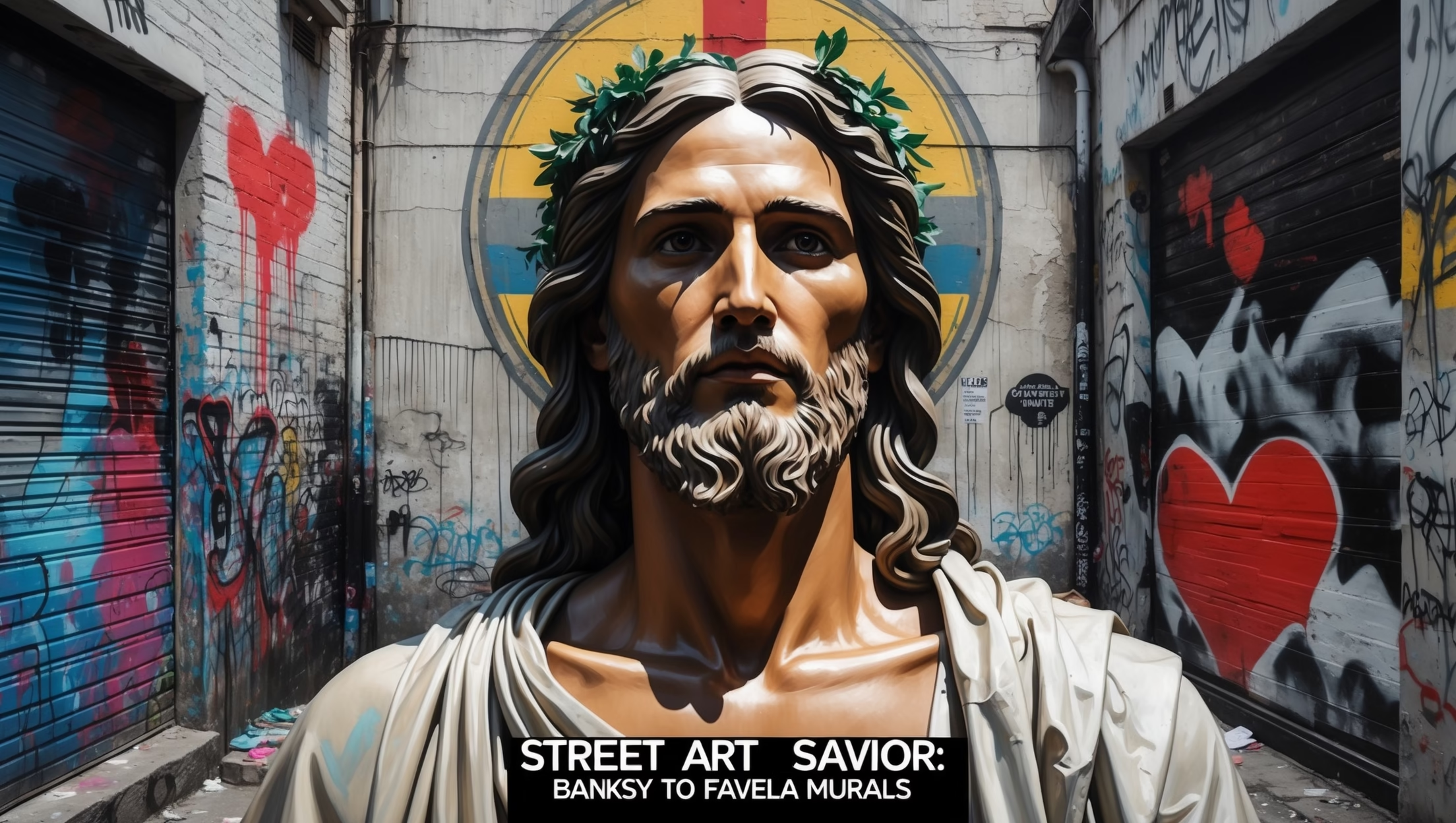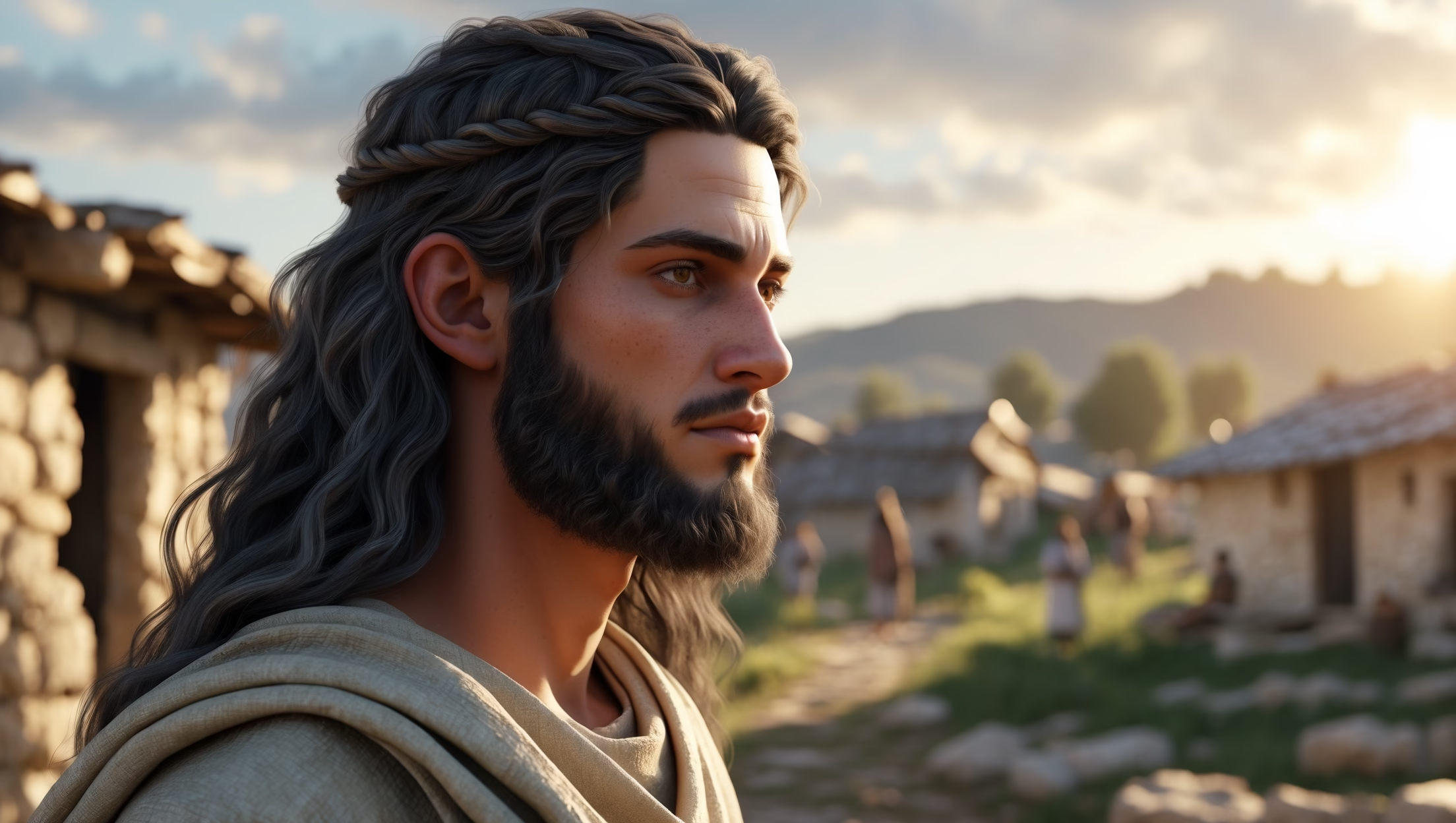How Guerrilla Art Reclaims Sacred Imagery in the Modern Urban Landscape
From the alleyways of London to the hillsides of Rio de Janeiro, street artists have appropriated one of history’s most recognizable figures—Jesus Christ—to communicate social critique, spiritual reflection, and political resistance. Unlike traditional church murals or Renaissance altarpieces, these artworks inhabit the public sphere, accessible to passersby and often fleeting in existence. The Street Art Savior phenomenon demonstrates how Christ’s image continues to inspire creativity, provoke debate, and engage audiences outside conventional religious spaces.

1. Banksy’s Urban Gospel
The elusive British artist Banksy has repeatedly used Jesus imagery to comment on injustice, inequality, and institutional authority.
- “Scarlet Cross” (London, 2020): A crucifix constructed from police barricades drew attention to state surveillance, law enforcement power, and public protest.
- Themes: Sacrifice, oppression, and societal critique intersect; the traditional crucifix is reframed as a symbol of resistance.
- Technique: Stenciling and site-specific installation make the work ephemeral, emphasizing the impermanence of political regimes compared to enduring spiritual principles.
Banksy’s use of Jesus functions on multiple levels: aesthetic, theological, and ethical. By placing Christ in public urban landscapes, he bridges sacred narrative and contemporary social commentary, prompting viewers to reconsider power, obedience, and morality.
2. Brazilian Favelas: Localizing the Messiah
In Rio de Janeiro and São Paulo, street artists transform Christ into a figure reflecting community identity and struggle.
- Favela Madonnas: Murals depict Jesus wearing soccer jerseys, often with symbols of local neighborhoods. This localization makes the divine figure relatable to residents, reinforcing community pride and moral resilience.
- Themes: Poverty, social inequality, gang violence, and hope. The murals often appear near schools, community centers, and informal markets, where institutional religious presence is limited.
- Artist Testimony: São Paulo muralist Marcos Beccari explains, “We paint Christ where the church won’t go,” highlighting the intersection of creativity, devotion, and social engagement.
These works illustrate how Christ’s image becomes a vessel for empowerment, offering both spiritual inspiration and a moral critique of social systems.
3. Middle Eastern Urban Expression: Tehran’s Underground Jesus
In countries with religious and political restrictions, street art becomes a medium of clandestine devotion and protest.
- Tehran Stencils: Artists depict Jesus weeping over public demonstrations, police brutality, and economic hardship.
- Symbolism: The tears humanize suffering while asserting moral authority over oppression.
- Cultural Tension: Such works risk censorship or arrest, demonstrating the political stakes of religious iconography in public art.
In this context, Jesus functions simultaneously as a prophetic witness and a spiritual ally for marginalized populations.
4. Social Media Amplification
Street art’s ephemeral nature is amplified through digital networks.
- Hashtag Movements: #JesusWasARefugee campaigns recontextualize biblical narratives for contemporary social justice, linking murals, images, and activism across continents.
- Viral Reach: Photographs of urban Jesus imagery circulate globally, inspiring discourse on immigration, inequality, and moral responsibility.
- Digital Resurrection: Even when walls are painted over, destroyed, or weathered, online platforms preserve the artwork, extending its theological and cultural influence.
This digital layer allows street artists to create global conversations, where the figure of Jesus becomes both a local and transnational symbol.
5. Cultural and Theological Impact
The Street Art Savior movement reshapes perceptions of sacred imagery in several ways:
- Accessibility: By appearing in public spaces, Jesus moves beyond churches and museums, engaging those who may never enter formal religious settings.
- Recontextualization: Traditional iconography is blended with contemporary social issues, making Christ a symbol of solidarity with the oppressed.
- Debate: Legal disputes over vandalism versus protected art raise questions about ownership of religious imagery and freedom of expression.
- Interfaith Dialogue: Some murals incorporate multiple religious symbols, prompting reflection on universality and shared values.
Ultimately, these works remind us that Jesus’ cultural resonance extends beyond theology into ethical, political, and aesthetic domains.
6. Artistic Techniques and Innovation
Street artists employ diverse methods to convey theological and social messages:
- Stencil Art: Quick, repeatable, and anonymous—ideal for politically sensitive environments.
- Spray Paint Murals: Large-scale, visually striking, often in underserved neighborhoods.
- Found Objects and Installations: As with Banksy’s “Scarlet Cross,” repurposed materials carry symbolic weight.
- Interactive Elements: QR codes, augmented reality overlays, and social media campaigns extend engagement beyond the wall itself.
Through these techniques, artists invite participation, turning observers into active interpreters of Christ’s message.
7. Global Relevance and Legacy
The Street Art Savior phenomenon demonstrates Jesus’ adaptability as a cultural and ethical icon:
- Cross-Cultural Resonance: From Europe to South America to the Middle East, Jesus becomes a medium for dialogue on justice, suffering, and hope.
- Countercultural Expression: Marginalized communities and underground artists reclaim sacred imagery to critique power structures, consumerism, and social apathy.
- Inspiration for New Media: Social media, virtual exhibitions, and interactive urban tours ensure that these interpretations reach audiences far beyond the local context.
By turning sacred narratives into accessible, provocative public art, these artists remind us that the story of Jesus remains alive, contested, and creatively inspiring.
Conclusion
From Banksy’s barricade crucifix to favela murals and Tehran underground stencils, street artists reinterpret Jesus for the modern urban milieu. These works bridge religion, politics, and art, demonstrating how Christ continues to inspire ethical reflection and social activism. Far from being confined to churches or books, the figure of Jesus thrives in public spaces, digital networks, and creative subcultures, challenging viewers to reconsider their own responsibilities to justice, compassion, and community.
In an era of rapid urbanization, social inequality, and digital communication, the Street Art Savior ensures that Jesus’ image—and the values he embodies—remain both visible and provocative, affirming the enduring power of sacred narratives in the contemporary world.










